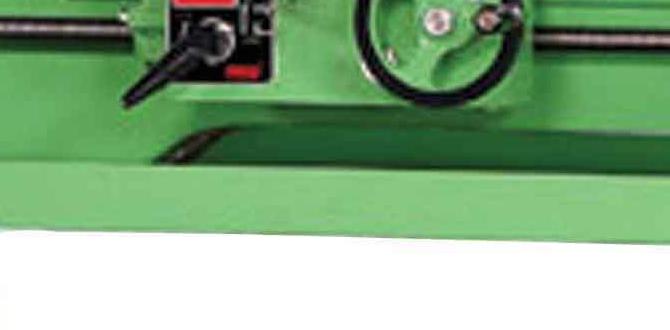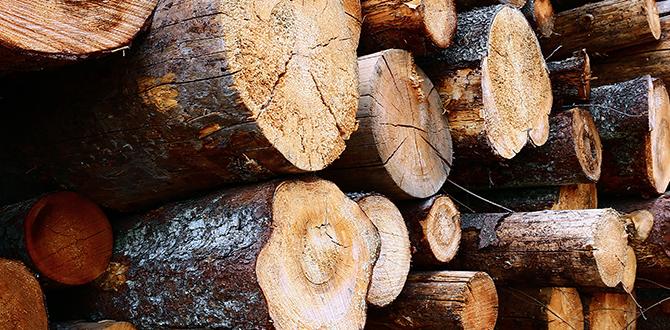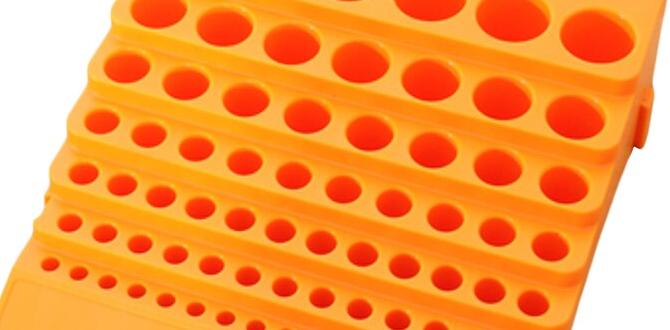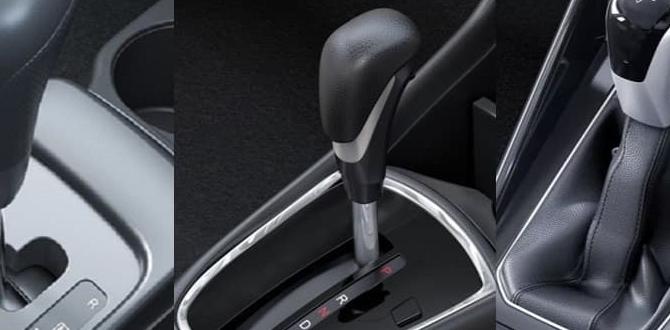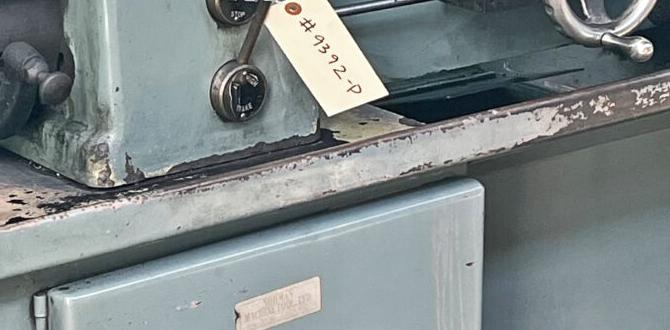Have you ever wondered how to keep your metal lathe running smoothly? Proper care is key, especially for the compound rest. This part helps you make precise cuts. Without it, your projects could go wrong. Imagine spending hours on a piece, only to find it won’t work correctly.
Just like any tool, a metal lathe needs regular maintenance. Did you know that a few simple steps can keep it in top shape? This guide will show you how to maintain the metal lathe compound rest. It will help you avoid costly repairs and downtime.
Join us as we explore tips and tricks for keeping your lathe ready for action. You’ll learn how to spot problems before they become big issues. With this knowledge, you can enjoy working on your projects with confidence!
Comprehensive Maintenance Guide For Metal Lathe Compound Rest

Maintenance Guide for Metal Lathe Compound Rest
Taking care of your metal lathe’s compound rest is crucial for smooth operation. Regular cleaning and lubrication keep it in great shape. Did you know that a well-maintained compound rest can enhance your machining accuracy? It’s true! Inspecting for wear and tear, and adjusting parts when needed, ensures long-lasting performance. Additionally, always refer to your machine’s manual for specific maintenance tips. Following these steps helps avoid costly repairs and extends the life of your lathe.Understanding the Metal Lathe Compound Rest
Definition and function of the compound rest. Importance of the compound rest in lathe operations.The compound rest is a crucial part of a metal lathe. It holds the cutting tool and allows precise movements. This tool makes it easy to cut different shapes and sizes. Without it, working with a lathe would be much harder. The compound rest ensures accuracy, which is key for good results. It helps in turning metal smoothly, creating high-quality parts.
Why is the compound rest important?
The compound rest is important for several reasons:
- Precision: It allows for exact cutting angles.
- Stability: Keeps tools steady during operations.
- Flexibility: Adjusts for various tasks quickly.
Common Issues and Signs of Wear
Identifying common problems with the compound rest. Signs that indicate maintenance is needed.Every tool has its problems. With a metal lathe, it’s key to spot issues early. Look for:
- Sticking or hard movement of the compound rest.
- Excessive play or looseness.
- Visible wear on moving parts.
- Unusual noises during operation.
These signs mean it’s time for maintenance. Ignoring them can lead to bigger problems later.
How do you know when maintenance is needed?
You can tell by watching for signs like gaps in parts and rough movement. Regular check-ups keep your lathe running smoothly.
Essential Tools and Materials for Maintenance
List of necessary tools and equipment for maintenance. Recommended lubricants and cleaning materials.Keeping your metal lathe in great shape is important for smooth work. Here are some tools you’ll need for maintenance guide metal lathe compound rest:
- Wrenches
- Screwdrivers
- Shop towels
- Cleaning brush
For lubrication and cleaning, use these recommended materials:
- Machine oil
- Grease
- Solvent
These items will help keep your lathe working well.
What tools do I need for lathe maintenance?
You need basic tools like a wrench and screwdriver. Also, cleaning items like shop towels are very useful.
Step-by-Step Maintenance Procedures
Detailed cleaning process for the compound rest. Lubrication techniques for optimal performance. Adjustments and alignments to ensure precision.To keep your metal lathe compound rest in top shape, start with a thorough cleaning. Use a soft cloth and a gentle cleaner to wipe away dust and grime. Remember, a clean machine is a happy machine! Next, apply lubrication to all moving parts. This helps everything run smoothly—like a well-oiled dance! Finally, check the adjustments and alignments. Make sure everything is tight and straight. You want precision, not a wobbly rollercoaster!
| Maintenance Step | Action Required |
|---|---|
| Cleaning | Wipe with soft cloth and gentle cleaner |
| Lubrication | Apply lubricant to moving parts |
| Adjustments | Check for tightness and alignment |
Preventive Maintenance Tips
Daily, weekly, and monthly maintenance tasks. Best practices to prolong the life of the compound rest.Taking care of your compound rest can make it last longer and work better. Start with daily checks: wipe off dirt and oil, and check for loose screws. Weekly, oil the moving parts and tighten any bolts. Monthly maintenance should include a deeper clean and inspecting for any wear. Remember, a well-maintained lathe is like a happy puppy—it will work hard and not bite you back! Keep it clean and well-oiled.
| Maintenance Task | Frequency |
|---|---|
| Wipe off dirt and oil | Daily |
| Oil moving parts | Weekly |
| Inspect for wear | Monthly |
Following these tips helps keep your compound rest in tip-top shape. Remember, a happy machine means fewer problems and more time for fun projects!
Troubleshooting Common Problems
Solutions for frequent issues encountered. When to seek professional help.Metal lathes can sometimes act up. Here are some common issues and quick fixes:
- Check for loose belts. Tighten them for better performance.
- Look at the lubrication. If it’s low, add more oil.
- Inspect the tool holder. Make sure tools are secured tightly.
If problems continue, it might be best to seek professional help. Experts know how to fix tricky problems safely. Remember, some tasks can be too tough or dangerous to handle alone!
When should I ask for help?
If issues persist after trying fixes, or if the machine makes odd noises, consult a professional. Being safe is always smart!
Upgrades and Modifications for Efficiency
Suggested upgrades to enhance compound rest performance. Potential modifications for specialized tasks.Upgrading your compound rest can give your metal lathe a turbo boost! First, consider adding a precision spring for better support. This little gem keeps everything steady, ensuring smooth cuts. Next, swap out the standard handles for ergonomic ones. Your hands will thank you, especially during long projects! For specialized tasks, a quick-change tool post can be a game changer. It allows you to switch tools swiftly, making you the superhero of the workshop. Don’t forget to keep it clean too—dust bunnies hate a tidy workspace!
| Upgrade/Modification | Benefits |
|---|---|
| Precision Spring | Improves stability for cleaner cuts |
| Ergonomic Handles | Reduces hand fatigue during work |
| Quick-Change Tool Post | Speeds up tool swaps for efficiency |
Resources for Further Learning
Recommended books and manuals on lathe maintenance. Online forums and communities for sharing knowledge and experiences.Many helpful resources exist for learning about lathe maintenance. Some great books and manuals are available to guide you. Check out these options:
- The Lathe Book – A guide to using and maintaining lathes.
- Getting Started in Project Management – Tips for planning your lathe projects.
Online forums and communities are also valuable. They allow you to share experiences and ask questions. Talking to others can help so much. You might learn new tricks and tips!
What resources are the best for learning about lathe maintenance?
Look for books like The Lathe Book. Join online forums to share and learn.
Conclusion
In summary, a maintenance guide for your metal lathe’s compound rest is essential. Regular cleaning keeps your lathe working smoothly. Lubricate parts to prevent wear and tear. Check for tightness to avoid accidents. By following these steps, you ensure better performance and longevity. For more tips, consider reading other maintenance guides and keep your lathe running like new!FAQs
Sure! Here Are Five Related Questions On The Topic Of Maintaining A Metal Lathe’S Compound Rest:To keep the compound rest of a metal lathe in good shape, you should clean it regularly. Use a soft cloth to wipe off dirt and oil. It’s also important to check for any loose screws or parts and tighten them if needed. You should apply a little bit of oil to moving parts to help them work smoothly. Taking these steps helps your lathe work better and last longer!
Sure! Please share the question you’d like me to answer.
What Are The Key Components Of The Compound Rest That Require Regular Maintenance?The key parts of the compound rest that need care are the slideways, the screws, and the bearings. You should clean the slideways to keep them smooth. It’s also important to oil the screws so they move easily. Check the bearings for wear and replace them if needed. Keeping these parts in good shape helps the machine work well!
How Often Should The Compound Rest Be Cleaned And Lubricated To Ensure Optimal Performance?You should clean and lubricate the compound rest often. Doing it every few weeks is a good rule. If you use it a lot, you might want to clean it more often. This helps it work better and last longer. Always check it to keep it in great shape!
What Type Of Lubricant Is Recommended For Use On The Compound Rest, And How Should It Be Applied?You should use a light machine oil on the compound rest. It helps the parts move smoothly. To apply it, put a few drops on the moving parts. Then, move them back and forth to spread the oil evenly. Wipe off any extra oil with a cloth.
What Are Some Common Signs That The Compound Rest Is In Need Of Maintenance Or Adjustment?You might notice a few signs that the compound rest needs help. First, it may feel loose or wobbly when you use it. You may also see rust or dirt on it. Sometimes, it doesn’t move smoothly or makes strange noises. If you notice these things, it’s time to check or fix it!
How Can Proper Maintenance Of The Compound Rest Improve The Accuracy And Lifespan Of A Metal Lathe?Taking care of the compound rest helps your metal lathe work better and last longer. Regular cleaning keeps dust away, which helps the parts move smoothly. Lubricating the moving parts prevents them from getting stuck or worn out. This means you make better, more precise cuts, and your lathe will be happy for years to come!
{“@context”:”https://schema.org”,”@type”: “FAQPage”,”mainEntity”:[{“@type”: “Question”,”name”: “Sure! Here Are Five Related Questions On The Topic Of Maintaining A Metal Lathe’S Compound Rest:”,”acceptedAnswer”: {“@type”: “Answer”,”text”: “To keep the compound rest of a metal lathe in good shape, you should clean it regularly. Use a soft cloth to wipe off dirt and oil. It’s also important to check for any loose screws or parts and tighten them if needed. You should apply a little bit of oil to moving parts to help them work smoothly. Taking these steps helps your lathe work better and last longer!”}},{“@type”: “Question”,”name”: “”,”acceptedAnswer”: {“@type”: “Answer”,”text”: “Sure! Please share the question you’d like me to answer.”}},{“@type”: “Question”,”name”: “What Are The Key Components Of The Compound Rest That Require Regular Maintenance?”,”acceptedAnswer”: {“@type”: “Answer”,”text”: “The key parts of the compound rest that need care are the slideways, the screws, and the bearings. You should clean the slideways to keep them smooth. It’s also important to oil the screws so they move easily. Check the bearings for wear and replace them if needed. Keeping these parts in good shape helps the machine work well!”}},{“@type”: “Question”,”name”: “How Often Should The Compound Rest Be Cleaned And Lubricated To Ensure Optimal Performance?”,”acceptedAnswer”: {“@type”: “Answer”,”text”: “You should clean and lubricate the compound rest often. Doing it every few weeks is a good rule. If you use it a lot, you might want to clean it more often. This helps it work better and last longer. Always check it to keep it in great shape!”}},{“@type”: “Question”,”name”: “What Type Of Lubricant Is Recommended For Use On The Compound Rest, And How Should It Be Applied?”,”acceptedAnswer”: {“@type”: “Answer”,”text”: “You should use a light machine oil on the compound rest. It helps the parts move smoothly. To apply it, put a few drops on the moving parts. Then, move them back and forth to spread the oil evenly. Wipe off any extra oil with a cloth.”}},{“@type”: “Question”,”name”: “What Are Some Common Signs That The Compound Rest Is In Need Of Maintenance Or Adjustment?”,”acceptedAnswer”: {“@type”: “Answer”,”text”: “You might notice a few signs that the compound rest needs help. First, it may feel loose or wobbly when you use it. You may also see rust or dirt on it. Sometimes, it doesn’t move smoothly or makes strange noises. If you notice these things, it’s time to check or fix it!”}},{“@type”: “Question”,”name”: “How Can Proper Maintenance Of The Compound Rest Improve The Accuracy And Lifespan Of A Metal Lathe?”,”acceptedAnswer”: {“@type”: “Answer”,”text”: “Taking care of the compound rest helps your metal lathe work better and last longer. Regular cleaning keeps dust away, which helps the parts move smoothly. Lubricating the moving parts prevents them from getting stuck or worn out. This means you make better, more precise cuts, and your lathe will be happy for years to come!”}}]}
